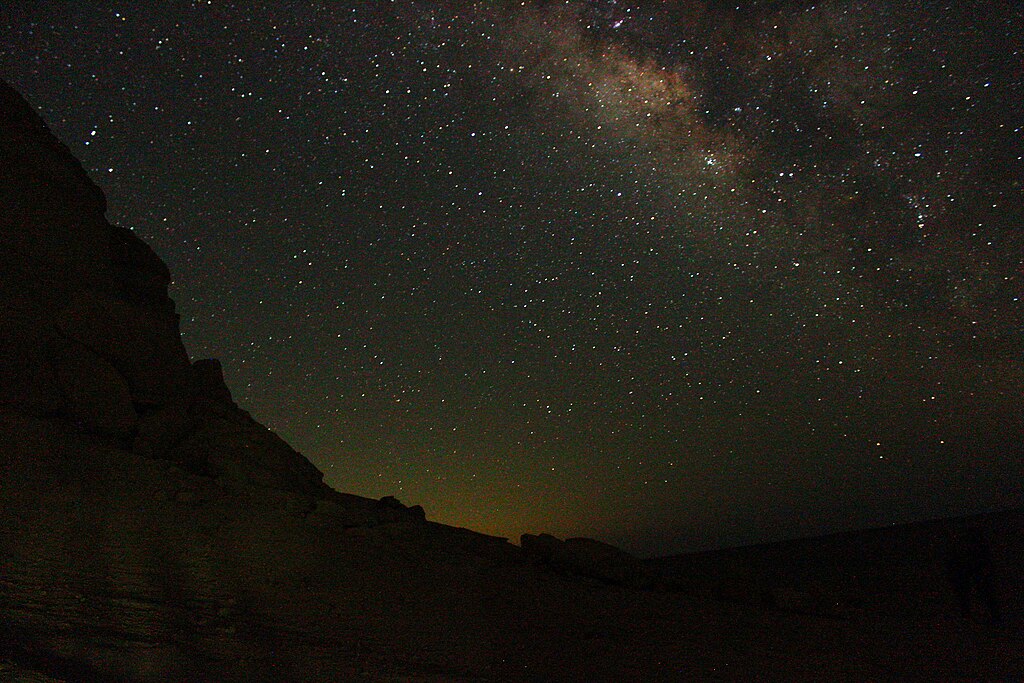
Aside from its rich culture and ancient history, Egypt is a stargazer’s paradise. This diverse nation is home to some of the most captivating stargazing locations, where visitors can immerse themselves in the vastness of the cosmos.
The beauty of stargazing in Egypt comes from its distinctive geographic location. The country’s positioning offers a spectacular view of celestial phenomena in both the Northern and Southern hemispheres.
For experienced stargazers or curious travelers looking for a deep, spiritual connection with the universe, these are seven of the country’s stargazing hotspots for a once-in-a-lifetime activity.
Wadi Al-Hitan

A remarkable paleontological and cultural site in Egypt’s Western Desert, Wadi Al-Hitan is renowned for its rare fossil collection of prehistoric whales, showcasing the evolution of these marine mammals from land-dwelling animals to the fully adapted aquatic creatures we know today.
Far away from the bright lights of cities, the desert landscape surrounding the UNESCO World Heritage Site offers a perfect setting for observing the wonders of the night sky.
The White Desert

Located in the Farafra Depression in Egypt’s Western Desert, the White Desert is a mesmerizing natural wonder – a surreal landscape unique for its chalk-white rock formations, sculpted by the erosive forces of wind and sand over thousands of years.
During the day, the stark white formations contrast against the blue sky, creating a stunning visual spectacle, while at night, the area comes alive with a heavenly display of stars in the clear desert sky, which is perfect for those seeking a breathtaking stargazing spot.
Gabal Elba

Gabal Elba is an imposing granite mountain located in the southeastern corner of Egypt. Part of the Red Sea Mountains, it is one of the highest peaks in Egypt, reaching an elevation of around 1,435 meters above sea level.
Gabal Elba and its surrounding national park are well-known for their unique biodiversity and rich natural heritage. Despite the arid environment of the surrounding desert, the mountain is awash in greenery after the rainy season each spring, supporting a variety of plant and animal species.
The high altitude creates optimal conditions for stargazing while the clarity of the desert air and the mountain’s isolation from urban centers allow visitors to witness an unpolluted view of the night sky.
Siwa Oasis

Situated approximately 50 kilometers east of the Libyan border, Siwa Oasis is an isolated haven surrounded by vast dunes and salt lakes. It is one of Egypt’s most well-known remote oases, offering a unique blend of natural beauty and cultural heritage.
The oasis is famous for its lush date palm groves, natural springs, and freshwater lakes, which create a striking contrast against the surrounding arid desert landscape.
Siwa’s night skies are renowned for their ambiance and tranquility, putting the oasis on the map as one of the most peaceful spots for visitors to camp and gaze at the tapestry of an endless universe above them.
Wadi Al-Gemal

Located in the Eastern Desert along the Red Sea coast, Wadi Al-Gemal is another captivating natural site in Egypt. The natural protectorate covers an expansive area of approximately 7,450 square kilometers, teeming with diverse ecosystems, historical sites, and unique landscapes.
The protectorate offers a myriad of activities, including stargazing, hiking, wildlife watching, and eco-tours that showcase the unique flora and fauna of the region. Designated as a protected area in 2003, Wadi Al-Gemal plays a vital role in conservation efforts, preserving delicate ecosystems and promoting sustainable tourism.
The desert’s remoteness and minimal light pollution provide an excellent opportunity to observe the Milky Way’s arm stretching across the night sky.
Saint Catherine

Mount Catherine is the highest peak in Egypt and the entire Sinai Peninsula. It is situated in the southern part of the Sinai Mountains, close to the famous St. Catherine’s Monastery. Mount Catherine stands tall at approximately 2,629 meters above sea level.
For many travelers, climbing Mount Catherine is the thing to do when in Sinai, especially during the cooler months. The hike to the summit is a challenging but accessible trek, offering stunning panoramic views of the surrounding desert landscapes and neighboring peaks.
As night falls, stargazers scaling the mountain are treated to constellations, planets, and celestial bodies twinkling in the dark desert skies. The climb usually ends in the early morning hours so that visitors can witness a breathtaking sunrise.
Bahariya Oasis

Nestled between the dunes of Egypt’s Western Desert, the Bahariya Oasis is blessed with beautiful scenery, archaeological sites, and natural springs. The area boasts a rich history with traces of human settlement dating back to prehistoric eras.
The oasis is covered in darkness at night, owing to its remoteness from major urban centers, allowing visitors better to view the stars and celestial bodies above. The area is also relatively flat and slightly elevated, making it one of Egypt’s most sought-after stargazing spots.
Subscribe to the Egyptian Streets’ weekly newsletter! Catch up on the latest news, arts & culture headlines, exclusive features and more stories that matter, delivered straight to your inbox by clicking here.






Comments (2)
[…] A Nighttime Adventure: Egypt's 7 Celestial Gems for Stargazers […]
[…] A Nighttime Adventure: Egypt’s 7 Celestial Gems for Stargazers […]